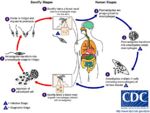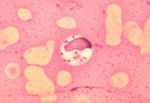Difference between revisions of "Leishmania"
Jump to navigation
Jump to search
Mariapavlou (talk | contribs) |
|||
| (41 intermediate revisions by 12 users not shown) | |||
| Line 1: | Line 1: | ||
| − | {{ | + | {{unfinished}} |
| − | + | ||
| − | |||
| − | |||
| − | |||
| − | |||
| − | |||
| − | |||
| − | |||
| − | |||
| − | |||
| − | |||
| − | |||
| − | |||
| − | |||
| − | |||
| − | |||
| − | |||
| − | |||
| − | |||
[[Image:Leishmania Life Cycle.jpg|thumb|right|150px|Leishmania Life Cycle - Wikimedia Commons]] | [[Image:Leishmania Life Cycle.jpg|thumb|right|150px|Leishmania Life Cycle - Wikimedia Commons]] | ||
[[Image:Leishmania donovani.jpg|thumb|right|150px|''Leishmania donovani'' in bone marrow cell - Dr. L.L. Moore, Jr.]] | [[Image:Leishmania donovani.jpg|thumb|right|150px|''Leishmania donovani'' in bone marrow cell - Dr. L.L. Moore, Jr.]] | ||
[[Image:Leishmania tropica.jpg|right|thumb|150px|''L. tropica'' <p> Yutaka TsutsumiWikiMedia Commons]] | [[Image:Leishmania tropica.jpg|right|thumb|150px|''L. tropica'' <p> Yutaka TsutsumiWikiMedia Commons]] | ||
| − | ''Leishmania spp.'' are intracellular parasites of [[Macrophage|macrophages]] from the same family as '' | + | |
| − | # | + | ==Overview== |
| − | # | + | ''Leishmania spp.'' are intracellular parasites of [[Macrophage|macrophages]] from the same family as ''Trypanosoma spp.''. These organisms parasitise human, dogs and wild animals throughout southern Europe, Africa, Asia and South America. The infection is transmitted by sandflies. Infection can cause both cutaneous and visceral disease. Three types of ''Leishmania spp.'' are described; |
| − | # | + | # Hypoplaria - found in lizards that ingest the sandfly intermediate host. Development occurs in the hindgut of the fly. |
| + | # Peripylaria - found in mammals and lizards, development occurs in the fore- and hindgut of the fly. | ||
| + | # Suprpylaria - found only in mammals transmitted by the bite of a sandfly, development occurs in the fore- and midgut of the fly. | ||
==Recognition== | ==Recognition== | ||
| − | |||
| − | + | *Ovoid shaped | |
| − | + | ||
| + | *Possesses a rod-shaped kinetoplast | ||
| + | |||
| + | *Has a rudimentary flagellum which does not project beyond the cell margin | ||
| + | |||
| + | *After the amastigote has transformed into a promastigote inside the [[Biting Flies#Psychodidae|sand fly]], the kinetoplast is situated in the posterior of the body | ||
| + | |||
| + | '''Life Cycle''' | ||
| + | *Transmitted by blood sucking [[Psychodidae|sand flies]] | ||
| + | **''Phlebotomus'' spp. in the Old World | ||
| + | **''Lutzomyia'' spp. in the New World | ||
| + | |||
| + | *The amastigote (morphological form) is found in vertebrate [[Macrophage|macrophages]] | ||
| + | |||
| + | *Ingested by [[Psychodidae|sand fly]] during feeding | ||
| + | **Transforms in [[Insecta|insect]] gut | ||
| − | + | *Multiplies and migrates to [[Insecta|insect]] proboscis | |
| + | **Inoculated during feeding | ||
| + | **Can be transmitted percutaneously if [[Psychodidae|sand fly]] crushed on skin | ||
| − | + | *Invades [[Macrophage|macrophages]] and reverts to amastigote | |
| − | + | *Multiplies by binary fission | |
| − | |||
| − | + | '''Pathogenesis''' | |
| + | *Infection of vertebrate host | ||
| + | **Produces foci of proliferating ''Leishmania''-infected [[Macrophage|macrophages]] in skin ('''cutaneous''') or internal organs ('''visceral''') | ||
| − | + | *Very long incubation period | |
| − | + | **Months to years | |
| − | + | *Many infected dogs are asymptomatic | |
| − | + | *Cutaneous form | |
| − | + | **Produces areas of ulceration on pinnae of [[Ear - Anatomy & Physiology|ears]], eyelids or on the [[Lips - Anatomy & Physiology|lips]] | |
| − | + | *Visceral form causes chronic wasting condition | |
| − | + | **Generalised eczema | |
| + | ***Loss of hair around eyes producing 'spectacle' effect | ||
| + | **Intermittent fever | ||
| + | **Generalised lymphadenopathy | ||
| − | + | *Long periods of remission followed by recurrence of clinical signs is not uncommon in infections | |
| − | |||
| − | + | *Involved in [[Parasitic skin infections - Pathology#Protozoa|skin infections]] | |
| − | + | '''Epidemiology''' | |
| − | + | *Disease dependent on [[Psychodidae|sand fly]] vectors | |
| − | + | **E.g. Common in dogs around the Mediterranean coast, foci around southern Europe and around Madrid | |
| − | |||
| − | |||
| − | |||
| + | *Reservoirs of infection | ||
| + | **E.g. Wild animals such as rodents and stray dogs | ||
| − | + | *Mechanisms of transmission | |
| + | **[[Psychodidae|sand fly]] bite | ||
| + | **Rarely through direct contact | ||
| + | |||
| + | *Leishmaniasis in British dogs | ||
| + | **Susceptible to infection if exposed whilst abroad in endemic areas as have no immunity | ||
| + | **No [[Psychodidae|sand flies]] in Britain but dogs have become infected whilst in contact with infected imported animals | ||
| + | |||
| + | '''Diagnosis''' | ||
| + | *Demonstrate ''Leishmania'' organisms | ||
| + | **In skin scraping or smears | ||
| + | **In joint fluid, [[Lymph Nodes - Anatomy & Physiology|lymph node]] or [[Bone Marrow - Anatomy & Physiology|bone marrow]] biopsies | ||
| + | |||
| + | '''Treatment and Control''' | ||
| + | *Chemotherapy | ||
| + | **Prolonged treatment, expensive, suppresses infection | ||
| + | **Does not cure infection | ||
| + | |||
| + | *Prevent [[Psychodidae|sand flies]] biting | ||
| + | **Collars, sprays containing [[Ectoparasiticides|insecticide]] with repellent effect | ||
| + | |||
| + | *Destruction of infected and stray dogs | ||
| + | **[[Psychodidae|Sand flies]] biting infected dogs may spread the disease to other dogs, humans and wildlife | ||
| + | **There is a slight possibility of transmission to humans by direct contact | ||
| + | |||
| + | |||
| + | In dogs | ||
| + | *disseminated disease of the monocyte-macrophage system | ||
| + | *protozoa; genus ''Leishmania'' | ||
| + | *increased travel means clinincal disease may be acquired in endemic areas but now presents to veterinarians in non-endemic areas | ||
| + | *lymph node aspirates contain macrophages with organisms | ||
| − | |||
[[Category:Tropical Protozoa]] | [[Category:Tropical Protozoa]] | ||
| − | [[Category: | + | |
| − | [[Category: | + | [[Category:To_Do_-_Parasites]] |
| + | [[Category:To_Do_-_NickJ]] | ||
Revision as of 13:46, 1 August 2010
| This article is still under construction. |
Overview
Leishmania spp. are intracellular parasites of macrophages from the same family as Trypanosoma spp.. These organisms parasitise human, dogs and wild animals throughout southern Europe, Africa, Asia and South America. The infection is transmitted by sandflies. Infection can cause both cutaneous and visceral disease. Three types of Leishmania spp. are described;
- Hypoplaria - found in lizards that ingest the sandfly intermediate host. Development occurs in the hindgut of the fly.
- Peripylaria - found in mammals and lizards, development occurs in the fore- and hindgut of the fly.
- Suprpylaria - found only in mammals transmitted by the bite of a sandfly, development occurs in the fore- and midgut of the fly.
Recognition
- Ovoid shaped
- Possesses a rod-shaped kinetoplast
- Has a rudimentary flagellum which does not project beyond the cell margin
- After the amastigote has transformed into a promastigote inside the sand fly, the kinetoplast is situated in the posterior of the body
Life Cycle
- Transmitted by blood sucking sand flies
- Phlebotomus spp. in the Old World
- Lutzomyia spp. in the New World
- The amastigote (morphological form) is found in vertebrate macrophages
- Multiplies and migrates to insect proboscis
- Inoculated during feeding
- Can be transmitted percutaneously if sand fly crushed on skin
- Invades macrophages and reverts to amastigote
- Multiplies by binary fission
Pathogenesis
- Infection of vertebrate host
- Produces foci of proliferating Leishmania-infected macrophages in skin (cutaneous) or internal organs (visceral)
- Very long incubation period
- Months to years
- Many infected dogs are asymptomatic
- Visceral form causes chronic wasting condition
- Generalised eczema
- Loss of hair around eyes producing 'spectacle' effect
- Intermittent fever
- Generalised lymphadenopathy
- Generalised eczema
- Long periods of remission followed by recurrence of clinical signs is not uncommon in infections
- Involved in skin infections
Epidemiology
- Disease dependent on sand fly vectors
- E.g. Common in dogs around the Mediterranean coast, foci around southern Europe and around Madrid
- Reservoirs of infection
- E.g. Wild animals such as rodents and stray dogs
- Mechanisms of transmission
- sand fly bite
- Rarely through direct contact
- Leishmaniasis in British dogs
- Susceptible to infection if exposed whilst abroad in endemic areas as have no immunity
- No sand flies in Britain but dogs have become infected whilst in contact with infected imported animals
Diagnosis
- Demonstrate Leishmania organisms
- In skin scraping or smears
- In joint fluid, lymph node or bone marrow biopsies
Treatment and Control
- Chemotherapy
- Prolonged treatment, expensive, suppresses infection
- Does not cure infection
- Prevent sand flies biting
- Collars, sprays containing insecticide with repellent effect
- Destruction of infected and stray dogs
- Sand flies biting infected dogs may spread the disease to other dogs, humans and wildlife
- There is a slight possibility of transmission to humans by direct contact
In dogs
- disseminated disease of the monocyte-macrophage system
- protozoa; genus Leishmania
- increased travel means clinincal disease may be acquired in endemic areas but now presents to veterinarians in non-endemic areas
- lymph node aspirates contain macrophages with organisms


